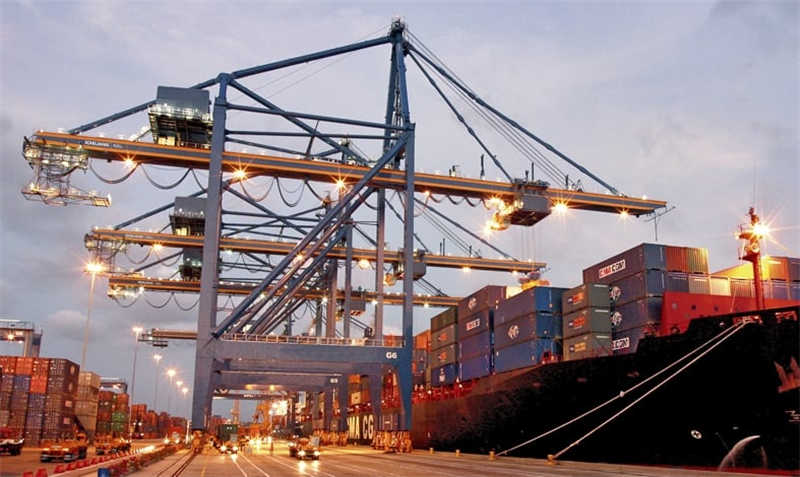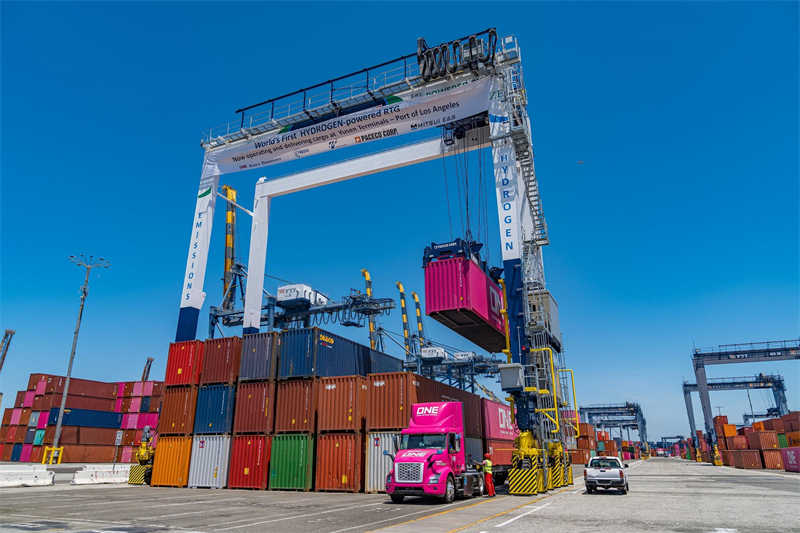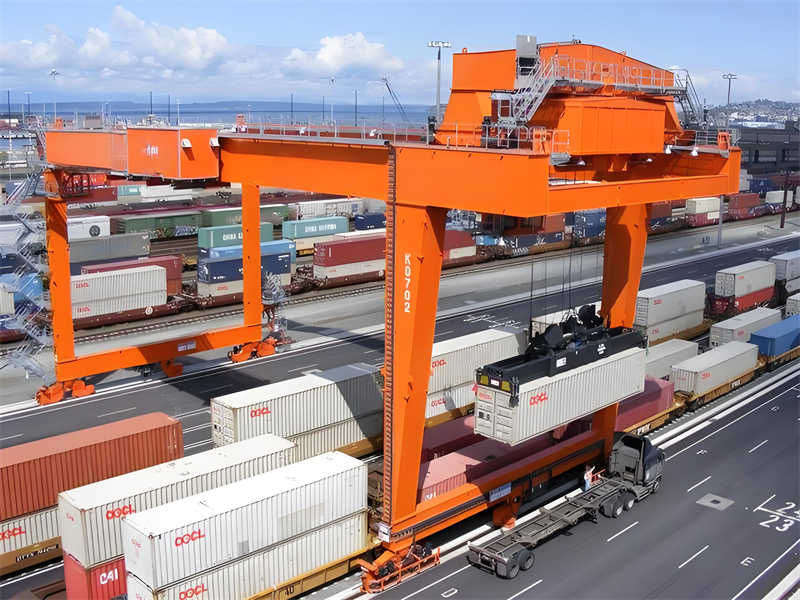Port Crane Types Comparison: A Comprehensive Guide by Dongqi Crane (2025 Edition)
1. Introduction
In today’s rapidly evolving global trade landscape, selecting the right port crane is a strategic decision that directly impacts operational efficiency, cost management, and long-term competitiveness. As a leading manufacturer of port handling equipment, Dongqi Crane specializes in Ship-to-Shore (STS) Cranes, Rubber-Tired Gantry (RTG) Cranes, and Rail-Mounted Gantry (RMG) Cranes – the three most critical crane types for modern container terminals.
This guide provides an in-depth comparison of these crane types, helping port operators, terminal managers, and logistics professionals make informed decisions for their 2025 infrastructure investments. We’ll examine:
✔ Key technical specifications of each crane type
✔ Productivity and cost comparisons
✔ Optimal use cases for different port sizes
✔ Emerging automation and green energy trends
Note: While some ports utilize Mobile Harbor Cranes, Dongqi Crane focuses on delivering superior fixed and semi-mobile solutions for container handling excellence.
2. Ship-to-Shore (STS) Cranes: The Giants of Container Handling
2.1 Technical Specifications
- Lifting Capacity: 50-120+ tons (ULCV models up to 150 tons)
- Outreach: 20-30+ container rows (up to 72m)
- Power Systems: Electric (most common) or hybrid
- Automation Levels: From basic remote control to fully AI-driven systems
Dongqi Crane’s STS Innovations:
- Smart Landing System™ (±5mm positioning accuracy)
- Dual-Trolley Configurations (up to 45 moves/hour)
- Energy Recovery Systems (saving 15-20% power)

2.2 Productivity Analysis
| Metric | Standard STS | Advanced (Dual-Trolley) |
|---|---|---|
| Moves/Hour | 25-30 | 35-45 |
| Vessel Turnaround | 18-24 hours | 12-16 hours |
| Labor Requirements | 1 operator/crane | 1 operator/3 cranes (automated) |
2.3 Cost Structure (2025 Estimates)
- Base Price: $6M-$20M (depending on specifications)
- Installation: $1M-$3M (rail infrastructure, electrical systems)
- Lifetime Maintenance (10 years): $2.5M-$4M
2.4 Ideal Use Cases
✔ Mega-container terminals (1M+ TEU annual throughput)
✔ Ports servicing ULCVs (20,000+ TEU vessels)
✔ Automation-focused greenfield projects
3. Rubber-Tired Gantry (RTG) Cranes: Flexible Yard Solutions
3.1 Technical Specifications
- Lifting Capacity: 30-50 tons
- Span: 6+1 to 10+1 container rows
- Mobility: 16-wheel configurations (8 driven/8 steering)
- Power Options: Diesel-electric hybrid or full electric
Dongqi Crane’s RTG Advantages:
- FlexiSpan™ System (adjustable container bay width)
- AutoSteer™ GPS Guidance (±2cm positioning)
- Battery-Swap Ready (5-minute recharge capability)

3.2 Productivity Analysis
| Metric | Standard RTG | Automated eRTG |
|---|---|---|
| Moves/Hour | 15-20 | 20-25 |
| Stack Height | 4-6 containers | 5-8 containers |
| Labor Requirements | 1 operator/crane | 1 operator/4 cranes |
3.3 Cost Structure (2025 Estimates)
- Base Price: $1.5M-$4M
- Yard Preparation: $200K-$500K/hectare
- Lifetime Maintenance (10 years): $1.8M-$3M
3.4 Ideal Use Cases
✔ Medium-sized terminals (200,000-800,000 TEU throughput)
✔ Multi-purpose ports with mixed operations
✔ Terminals requiring layout flexibility
4. Rail-Mounted Gantry (RMG) Cranes: High-Density Stacking Solutions
4.1 Technical Specifications
- Lifting Capacity: 40-60 tons
- Stacking Height: 5-8 containers
- Positioning Accuracy: ±1cm with laser guidance
- Automation Compatibility: Fully automated solutions available
Dongqi Crane’s RMG Features:
- High-Stability Dual-Rail System
- Integrated Container Recognition (OCR + RFID)
- Low-Noise Operation (<75dB at 10m)

4.2 Productivity Analysis
| Metric | Standard RMG | Automated RMG |
|---|---|---|
| Moves/Hour | 18-22 | 25-30 |
| Storage Density | +30% vs RTG | +50% vs RTG |
| Labor Requirements | 1 operator/2 cranes | 1 operator/6 cranes |
4.3 Cost Structure (2025 Estimates)
- Base Price: $2M-$5M
- Rail Infrastructure: $500K-$1.2M per 500m
- Lifetime Maintenance (10 years): $2M-$3.5M
4.4 Ideal Use Cases
✔ High-volume automated terminals
✔ Space-constrained ports needing vertical storage
✔ Cold ironing (shore power) compliant operations
5. Comparative Analysis: STS vs RTG vs RMG
5.1 Performance Comparison
| Parameter | STS Crane | RTG Crane | RMG Crane |
|---|---|---|---|
| Max Capacity | 120+ tons | 50 tons | 60 tons |
| Mobility | Fixed | High | Medium |
| Moves/Hour | 25-45 | 15-25 | 18-30 |
| Automation | L1-L3 | L1-L2 | L2-L3 |
| Best Throughput | >800,000 TEU | 200-800K TEU | 500K-1.5M TEU |
5.2 Cost Comparison (10-Year TCO)
| Crane Type | Initial Cost | Maintenance | Energy | Total |
|---|---|---|---|---|
| STS | $6M-$20M | $2.5M-$4M | $3M | $11.5M-$27M |
| RTG | $1.5M-$4M | $1.8M-$3M | $1.2M | $4.5M-$8.2M |
| RMG | $2M-$5M | $2M-$3.5M | $900K | $4.9M-$9.4M |
6. Future Trends Impacting Crane Selection (2025-2030)
6.1 Automation Advancements
- STS: AI-powered predictive movement (reducing cycle times by 15%)
- RTG: Swarm intelligence for coordinated yard operations
- RMG: Fully unmanned container handling systems
6.2 Green Technology Integration
- Electric Power Dominance: 80% of new RTGs/RMGs to be electric by 2027
- Hydrogen Fuel Cells: Pilot programs for STS cranes underway
- Energy Recovery: Regenerative braking becoming standard
6.3 Digital Integration
- Digital Twin Technology for predictive maintenance
- Blockchain-Enabled container tracking
- 5G-Connected crane fleets
7. How to Choose: Decision Framework
7.1 For Mega-Ports (1M+ TEU)
✅ Primary Equipment: Automated STS Cranes
✅ Secondary Equipment: RMG Cranes for stacking
✅ Recommended Setup: 1 STS per 300m quay + 1 RMG per 5 STS cranes
7.2 For Medium Ports (200K-1M TEU)
✅ Primary Equipment: RTG Cranes
✅ Supplemental: Limited STS if servicing Panamax+ vessels
✅ Recommended Setup: 1 RTG per 50,000 TEU annual volume
7.3 For Small Ports (<200K TEU)
✅ Primary Equipment: Standard RTG Cranes
✅ Future-Proofing: Electric-ready models
✅ Recommended Setup: 1 RTG per 2-3 berths
8. Why Choose Dongqi Crane?
8.1 Technology Leadership
- Smart Control Systems with 5G connectivity
- Industry 4.0 Integration for data-driven optimization
8.2 Cost Advantages
- 20-30% more cost-effective than European counterparts
- Localized service networks reducing maintenance costs
8.3 Customization Capabilities
- Tailored solutions for specific terminal layouts
- Hybrid power system options
8.4 Global Support
- 24/7 remote monitoring
- Spare parts available at all major ports
9. Conclusion
Selecting the right port crane requires careful consideration of:
✔ Current and future throughput needs
✔ Vessel size profiles
✔ Automation strategy
✔ Total cost of ownership
Dongqi Crane’s Recommended Approach:
- Large Terminals: STS + RMG combination for maximum efficiency
- Medium Terminals: RTG-focused with automation readiness
- Growing Ports: Modular solutions allowing future upgrades
Ready to Upgrade Your Port Equipment?
📞 Contact Dongqi Crane Experts Today
🌐 Visit: https://pk.craneyt.com/
📧 Email: sales010@cranesdq.com
With Dongqi Crane, build a future-ready port operation that balances performance, efficiency, and cost-effectiveness. 🚢⚡
